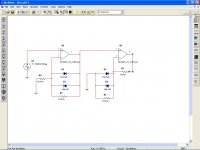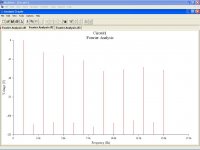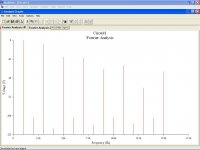Pavel, I'm not understanding what you're getting at. This doesn't seem related to Charles's anecdote (he still hasn't allowed anyone to see the files in question to dig at why there might be audible differences). Your files seem to be single tones with added harmonics of differing orders (shades of the Stereophile Test CD!).
What am I missing?
What am I missing?
WRT Charles claim, as I understand, the audible differences are caused by different data delivery methods used by the programmer. Just to give an example, maybe an extreme one, but representative: bursts of data vs. a continuous stream.
IMO that would make a difference in the electrical signals presented to the D/A converter. Even if you have an isolated interface, reclocking, etc.
This difference should be very difficult to measure, maybe it is very near or under the noise floor. I don´t think I would be able to hear it, but I don´t doubt that others can. Our hearing is an amazing instrument wrt sensitivity / signal to noise.
Best
Alex
IMO that would make a difference in the electrical signals presented to the D/A converter. Even if you have an isolated interface, reclocking, etc.
This difference should be very difficult to measure, maybe it is very near or under the noise floor. I don´t think I would be able to hear it, but I don´t doubt that others can. Our hearing is an amazing instrument wrt sensitivity / signal to noise.
Best
Alex
SY said:Pavel, I'm not understanding what you're getting at.
Just a guess, but maybe Pavel is saying that if you can't tell a difference between the files he's posted ... good luck in hearing a difference in the files Charles did.
Just a guess, but maybe Pavel is saying that if you can't tell a difference between the files he's posted ... good luck in hearing a difference in the files Charles did.
Dunno. It's mysterious; maybe Pavel will explain.
I have no trouble hearing the effects of data compression, but I doubt that I would hear those same effects on sine waves.
Math can do a decent model if everything is right. I have done a bit of that. Now reality gets a chance to rear its' head. I will build two non-linear amplifiers and measure them alone and in series both ways with and without global feedback.
Almost no one ever argues with actual measurements. Some one did once but it turns out they misread just about everything in the article. (See LA Vol. 1 Letters!)
Ed how about using non-linear blocks in LTspice? You can make your amplifier chain anyway you want; just put your formula in the nl-block and look at the transient simulation output.
jan
I haven't seen the article(s) but I do think a recent analog BSc/EE should at least have the "cultural" knowledge of the more advanced Control theory results - certainly a MSc EE and many other engineering/science MSc today will have taken enough Control Theory courses to give the answers off hand
locally Lipschitz, memoryless weakly nonlinear systems will give the least distortion with "maximum loop gain" Global feedback
in Audio we have Cherry's “Estimates of Nonlinear Distortion in Feedback Amplifiers” JAES V48#4 2000 - the backwards "equivalent distoriton" propagation and the series expansion inversions for 2nd and 3rd order nonlinearities add up to a quite illuminating framework for thinking about distortion in our audio feedback amp designs
locally Lipschitz, memoryless weakly nonlinear systems will give the least distortion with "maximum loop gain" Global feedback
in Audio we have Cherry's “Estimates of Nonlinear Distortion in Feedback Amplifiers” JAES V48#4 2000 - the backwards "equivalent distoriton" propagation and the series expansion inversions for 2nd and 3rd order nonlinearities add up to a quite illuminating framework for thinking about distortion in our audio feedback amp designs
So much for the 'professors'. IF audio design was exactly the same as servo design, then it would be fairly easy to move forward. As I first learned to design amps, my main job was designing servos, yet I separate the design approaches of the two.
Everyone please remember: There are hundreds of different audio amps and preamps to chose from. Just pick one, IF you think that it is 'easy' to make a 'successful' (defined by a class A rating in 'Stereophile' or its equivalent) audio product, and have many happy customers.
Everyone please remember: There are hundreds of different audio amps and preamps to chose from. Just pick one, IF you think that it is 'easy' to make a 'successful' (defined by a class A rating in 'Stereophile' or its equivalent) audio product, and have many happy customers.
Just pick one, IF you think that it is 'easy' to make a 'successful' (defined by a class A rating in 'Stereophile' or its equivalent) audio product, and have many happy customers.
That metric has far more to do with marketing, shcmoozing and luck than it does with advanced engineering.
se
That metric has far more to do with marketing, shcmoozing and luck than it does with advanced engineering.
se
Well, it's been observed that the Stereophile Class A amps have included high feedback, low feedback, tubes, transistors, FETs, hybrids, OTL, transfomer-coupled, high bandwidth, low bandwidth, ultra-low distortion, mediocre distortion- there really is no common technological or performance thread. The only common factors are high price and pretty casework. And, of course, evaluations are not done by ear alone.
So, yeah, it would seem to be a very nice marketing coup, rather than a technical one, not that there's anything wrong with that. Designers in this fashion niche gotta eat.
Ed how about using non-linear blocks in LTspice? You can make your amplifier chain anyway you want; just put your formula in the nl-block and look at the transient simulation output.
jan
There are lots of ways to do the math and simulations, but actual hardware is very easy to do and leaves little room for argument.
It is even easier to speculate about the math with even less usefulness!
PIM will not go away, just because people want it to. Look at Ron Quan's paper for further details.
If you are stuck at circa 1969 amplifiers.
>Have you figured out a new method for packaging them, or are you ordering them pre-packaged in TO247 or whatever ?
My error. The devices I got are ESBT's. They are in a 5 pin TO3-P
Yes, I would have liked Ron Quan to have measured some more 'modern' designs, instead of what we would call today as mid fi, but he felt that he made a conservatively based set of measurements that have been overlooked by others. I doubt that the test equipment at his disposal would bring out all what the ear can actually detect.
I warned him, after his paper was given, that 'critics' would jump on his examples, but he was steadfast. He is more conservative than some here, but if you have a question, you should direct it to him. He writes long and thorough e-mails, as shown by his correspondence with Bob Cordell, immediately after the AES presentation of his paper.
I suspect that he can EXTRAPOLATE his results to show that they are applicable to just about every practical electronic design. Why don't you ask him?
I warned him, after his paper was given, that 'critics' would jump on his examples, but he was steadfast. He is more conservative than some here, but if you have a question, you should direct it to him. He writes long and thorough e-mails, as shown by his correspondence with Bob Cordell, immediately after the AES presentation of his paper.
I suspect that he can EXTRAPOLATE his results to show that they are applicable to just about every practical electronic design. Why don't you ask him?
The devices I got are ESBT's.
Sequel paper, boss ?
Trudging on, if possible. The TIM problem that was usually related to slew rate, was solved 30 years ago for good, with SID=TIM, so DIM was born to INCLUDE TIM(SID) along with other distortion manifestations such as non-linear capacitance with voltage, and PIM.
PIM was stopped early by the AES (by not putting Matti Otala's purely mathematical paper in the JAES) and by Bob Cordell's early measurements that didn't seem to show anything much. About 15 years later, Barrie Gilbert showed the problem to exist, especially in slower IC's to a significant extent, even with IDEALIZED circuitry with nothing more wrong with them than a non-linear input stage (typical) and a lot of feedback, usually operating on a 6dB/octave slope. This is what re-ignited Walt Jung and me to follow up, once again, on PIM. Then, distortion characteristics accidently found in our early TIM paper from 1976, showed strong indications of PIM. This, at first, was thought to be very high order IM byproducts, BUT their calculations just don't fit the actual evidence. Of course, bringing this up here, did not make anyone happy. How dare I point out something that is OBVIOUSLY impossible? And so it goes.
Now, a long time colleague, Ron Quan, made a series of careful measurements of some bad examples of audio design and presented them at the AES. So far, nobody has shown any problems with his measurements, BUT he did not go far enough to convince the people here.
Bruno, in his summation appears to leave out PIM, did not seem to realize that we had settled the TIM-SID controversy and its comparative measurements 30 years ago, and that we found 2 tone IM interesting, but LESS SENSITIVE to what we were looking for. Yes, it had already been tried and put aside.
PIM was stopped early by the AES (by not putting Matti Otala's purely mathematical paper in the JAES) and by Bob Cordell's early measurements that didn't seem to show anything much. About 15 years later, Barrie Gilbert showed the problem to exist, especially in slower IC's to a significant extent, even with IDEALIZED circuitry with nothing more wrong with them than a non-linear input stage (typical) and a lot of feedback, usually operating on a 6dB/octave slope. This is what re-ignited Walt Jung and me to follow up, once again, on PIM. Then, distortion characteristics accidently found in our early TIM paper from 1976, showed strong indications of PIM. This, at first, was thought to be very high order IM byproducts, BUT their calculations just don't fit the actual evidence. Of course, bringing this up here, did not make anyone happy. How dare I point out something that is OBVIOUSLY impossible? And so it goes.
Now, a long time colleague, Ron Quan, made a series of careful measurements of some bad examples of audio design and presented them at the AES. So far, nobody has shown any problems with his measurements, BUT he did not go far enough to convince the people here.
Bruno, in his summation appears to leave out PIM, did not seem to realize that we had settled the TIM-SID controversy and its comparative measurements 30 years ago, and that we found 2 tone IM interesting, but LESS SENSITIVE to what we were looking for. Yes, it had already been tried and put aside.
Jan,
FYI
Schematic of high distortion cascaded amplifiers and the results. First is the schematic, second is output from the second amp as shown and third is with the amps positions swapped.
ES
FYI
Schematic of high distortion cascaded amplifiers and the results. First is the schematic, second is output from the second amp as shown and third is with the amps positions swapped.
ES
Attachments
Last edited:
- Status
- Not open for further replies.
- Home
- Member Areas
- The Lounge
- John Curl's Blowtorch preamplifier part II


